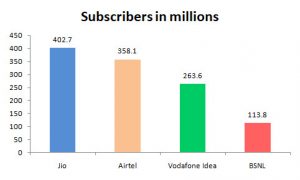
State-run BSNL will soon receive a Rs 1,64,000 crore revival package as the government looks to revive the once monopoly operator back from the brink. The Union cabinet on Wednesday cleared the package for the telecom service provider. The focus is on fresh capital infusion for upgrading the ailing company’s network, allocating 4G spectrum, de-stressing its balance sheet and augmenting its fibre network.
The BSNL revival package comes at a time when the three other telcos are looking to augment their networks with the upcoming 5G technology, while BSNL didn’t even participate in the 5G spectrum auctions. The four-year revival strategy follows a 2019 booster under which the government had announced a Rs 70,000 crore package. However, the same was utilised to cover a voluntary retirement scheme for BSNL employees. But whether BSNL will be able to compete with industry heavyweights — Mukesh Ambani’s Reliance Jio and Sunil Bharti Mittal’s Airtel – for a larger pie in the sector remains to be seen.
ALSO READ: Indian economy: IMF and other forecasters miss domestic, global pain points
The BSNL revival package
The company has been allotted a Rs 1.64-lakh crore package, of which Rs 43,964 crore will be the cash component. The rest of the package is non-cash support that will be spread over four years. The Union government will also allocate 4G spectrum to BSNL so that it can start the services. The government also believes that the company will make a net profit in the next 3-4 years, Communications minister Ashwini Vaishnaw said recently.
The Centre will fund capex of Rs 22,471 crore for developing 4G technology stack which is the likely capital expenditure (capex) for the next four years. It will also provide Rs 13,789 crore to BSNL as viability gap funding for commercially unviable rural wireline operations between FY15 and FY20.
To de-stress the balance sheet, Rs 33,404 crore statutory dues will be converted into equity and the government will provide sovereign guarantee for raising money to repay current loans.
The government is also looking at enhancing the operator’s wireline offering by proposing a merger of Bharat Broadband Nigam Ltd (BBNL) with BSNL. BBNL is the nodal agency for executing the BharatNet project. However, the infrastructure created under BharatNet is likely to continue to be a national asset, which means it will be accessible on a non-discriminatory basis to all telecom service providers.
Rationale behind revival of the bleeding telco
The government has been on a privatisation spree of late, but it has decided to further support BSNL and not monetise it like Air India. This can be attributed to several reasons.
ALSO READ: Telecom Industry: Adani foray may trigger a shakeup
One, BSNL has a deeper penetration in rural areas where it is more available than private networks. This is likely to help the government to push forward with its rural broadband agenda. More than a third of BSNL’s optical fibre customers are in rural areas, and the operator assists the government in expanding to far-flung areas with low-income consumers for operations that are commercially unviable.


BSNL is also heavily dependent on domestic component manufacturers unlike its peers. This helps in fostering a vendor base in the country. With BSNL launching 4G services and subsequently 5G, this will also take the domestic component industry along with it, especially when India has been sceptical of Chinese imports and border tensions have been brewing in the past few months. This is also in line with the government’s Make in India plan.
How BSNL lost its mojo
BSNL once enjoyed a monopoly in the Indian telecom market and has been in the country since when people used to share telephone connections in neighbourhoods. In fact, there are still places in India where other networks may not reach, but BSNL connections still work due to its higher penetration. Today, BSNL is at a stage where it is most likely to fold up without government intervention.
The slow but steady decline of BSNL can be largely attributed to the entry of private companies. Merely a decade after it launched its cellular operations, the telco started bleeding cash following the aggressive play of private players. As government policies started favouring private sector, BSNL continued to bleed.
BSNL is Internet Explorer in the age of Google
And then came the telecom revolution in the country with Jio’s foray into the sector. With its offering of free sims and data in the beginning to later roll out dirt cheap data plans, Reliance Jio brought a disruption to the telecom industry, leaving other players with no choice but to cut costs of tariff plans drastically. In fact, the telecom industry was once feared to become a monopoly or duopoly at best as Vodafone, Idea (which later became one entity VI) and Airtel were left scrambling to retain customers. BSNL was no outlier.
While India speedily adopted 4G in day-to-day lives via OTT consumption, mobile-game playing etc since Jio’s entry in 2016, BSNL is yet to roll out 4G services even while the world is gearing up for 5G. Of course, BSNL lost most of its subscribers. In layman terms, it will not be wrong to equate BSNL with Internet Explorer which has long been criticised for slow processing.
India is the second-largest telecommunications market in the world, making the country lucrative for investors and private companies. The total subscriber base, wireless subscriptions as well as wired broadband subscriptions have grown consistently in the country especially after Prime Minister Narendra Modi’s push for Digital India. As of December 2021, the total subscriber base stood at 1.18 billion. The Gross revenue of the telecom industry stood at Rs 64,801 crore ($8.74 billion) in the first quarter of FY22, according to government data.
It is expected that over the next five years, rise in mobile phone penetration and decline in data costs will add 500 million new internet users in India. That translates into new opportunities for businesses. The country has also been a hotbed for foreign investments with a consistently increasing subscriber base. The FDI inflows into the telecom industry stood at $38.25 billion from April 2000 to December 2021.
Prachi Gupta is an Assistant Editor with Policy Circle. She is a post graduate in English Literature from Lady Shri Ram College For Women, Delhi University. Prachi started her career as a correspondent with financialexpress.com. She specialises in policy impact studies.


